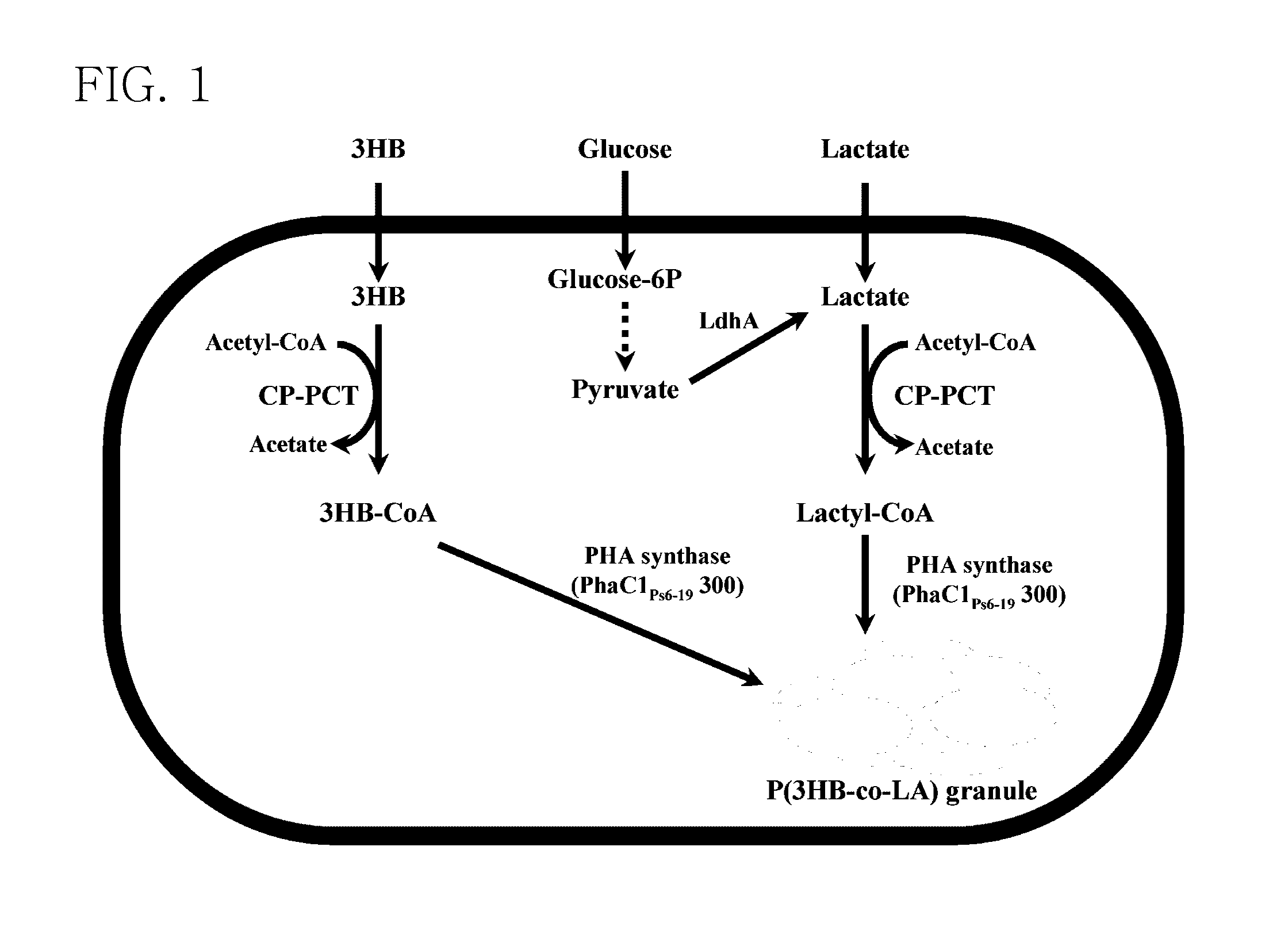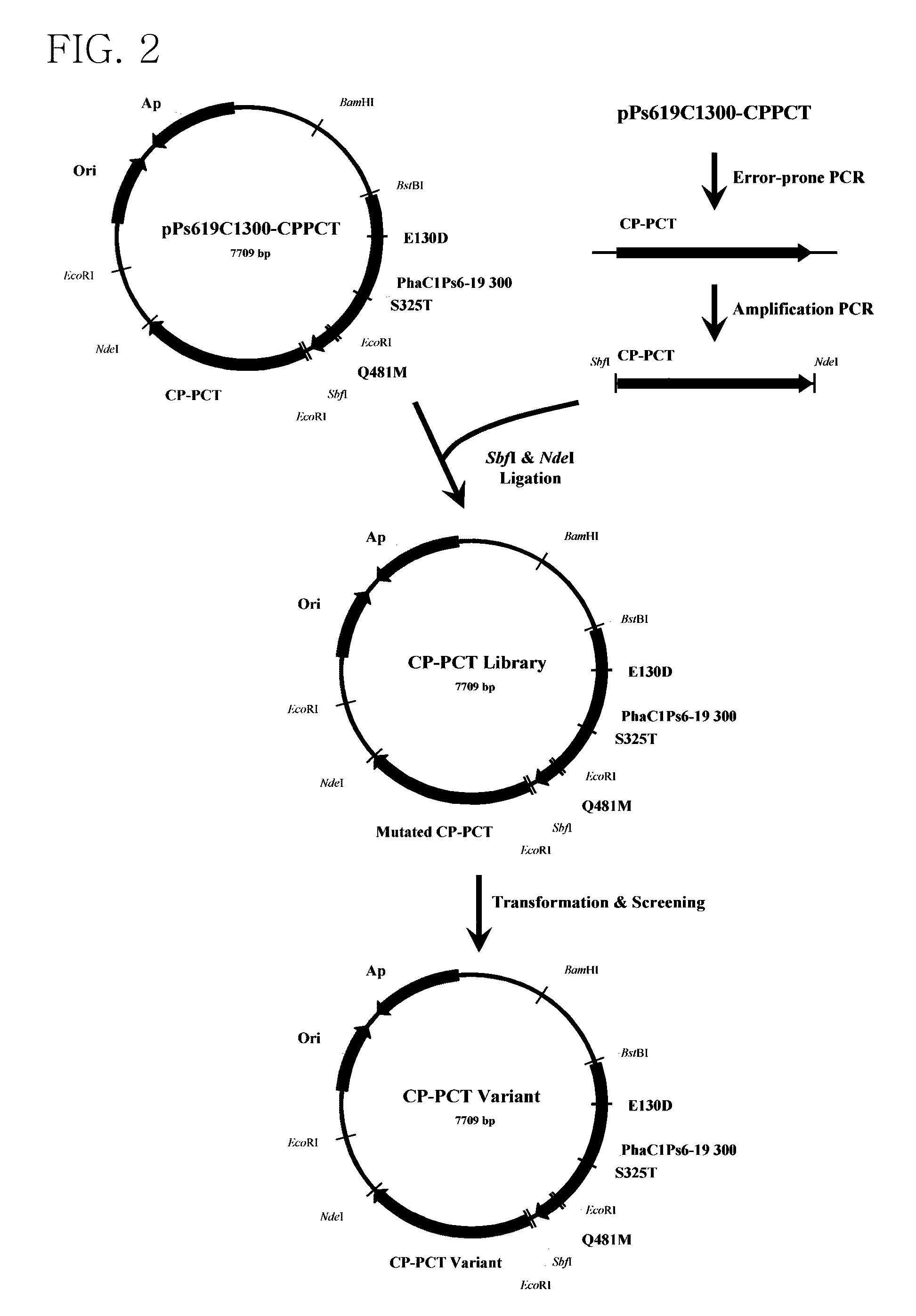Mutant of propionyl-CoA transferase from Clostridium propionicum and preparing method for PLA or PLA copolymer using the same
a technology of clostridium propionicum and transferase, which is applied in the direction of transferases, bulk chemical production, enzymology, etc., can solve the problems of difficult to synthesize pla copolymers composed of various types of monomers, commercially unavailable, and easy to remove, so as to facilitate the supply of lactyl-coa and efficient supply of lactyl-coa , the effect of high efficiency
- Summary
- Abstract
- Description
- Claims
- Application Information
AI Technical Summary
Benefits of technology
Problems solved by technology
Method used
Image
Examples
example 1-1
Cloning of a PHA Synthase Gene from Pseudomonas sp. 6-19 and Preparation of Expression Vector
[0044]In order to separate PHA synthase ((phaC1Ps6-19) gene from Pseudomonas sp. 6-19 (KCTC 11027BP) used in the present invention, the total DNA of Pseudomonas sp. 6-19 was extracted, primers having base sequences of SEQ ID NOs: 5 and 6 were prepared based on a sequence of the phaC1Ps6-19 gene (Ae-jin Song, Master's Thesis, Department of Chemical and Biomolecular Engineering, KAIST, 2004), and polymerase chain reaction (PCR) was performed to obtain the phaC1Ps6-19 gene.
[0045]
SEQ ID NO: 5:5′-GAG AGA CAA TCA AAT CAT GAG TAA CAA GAG TAACG-3′SEQ ID NO: 6:5′-CAC TCA TGC AAG CGT CAC CGT TCG TGC ACG TAC-3′
[0046]As a result of performing Agarose gel electrophoresis of the PCR product, a 1.7-kbp gene fragment corresponding to phaC1Ps6-19 gene was confirmed.
[0047]A DNA fragment containing a PHB-producing operon from Ralstonia eutropha H16 was cut with BamHI / EcoRI from a pSYL105 vector (Lee et al., Bi...
example 1-2
Preparation of a Substrate-Specific Mutant of a PHA Synthase from Pseudomonas sp. 6-19
[0053]Among various kinds of PHA synthases, a Type II PHA synthase is known as a medium-chain-length PHA (MCL-PHA) synthase for polymerizing a substrate having relatively many carbon atoms, and the MCL-PHA synthase is expected to be very applicable to production of a PLA copolymer. Although phaC1 synthase from Pseudomonas sp. 61-3, which has a high homology with the phaC1Ps6-19 synthase obtained according to the present invention, is the Type II synthase, it was reported that the phaC1 synthase had a relatively wide range of substrate specificity (Matsusaki et al., J. Bacteriol., 180:6459, 1998), and results of research in a mutant suitable for production of short-chain-length PHA (SCL-PHA) were reported (Takase et al., Biomacromolecules, 5:480, 2004). Based on the above, the present inventors found three amino-acid sites affecting SCL activation via amino-acid sequence arrangement analysis, and pr...
example 1-3
Preparation and Screening of a Library of a Mutant of Propionyl-CoA Transferase from Clostridium propionicum
[0056]In the present example, in order to provide lactyl-CoA that is a monomer required for synthesis of PLA and PLA copolymer, propionyl-CoA transferase from Clostridium propionicum (CP-PCT) was used and its sequence was represented by SEQ ID NO: 3. A fragment obtained by performing PCR on chromosomal DNA of Clostridium propionicum using primers of SEQ ID NOs: 21 and 22 was used as CP-PCT. In this case, an NdeI site existing in wild-type CP-PCT was removed using SDM to facilitate cloning.
[0057]
SEQ ID NO: 21:5′-GGA ATT CAT GAG AAA GGT TCC CAT TAT TAC CGC AGATGA-3′SEQ ID NO: 22:5′-GC TCT AGA TTA GGA CTT CAT TTC CTT CAG ACC CATTAA GCC TTC TG-3′
[0058]Also, overlapping PCR was performed using a primer of SEQ ID NOs: 23 and 24 in order to add a SbfI / NdeI recognition site.
[0059]
SEQ ID NO: 23:5′-agg cct gca ggc gga taa caa ttt cac aca gg-3′SEQ ID NO: 24:5′-gcc cat atg tct aga tta gg...
PUM
| Property | Measurement | Unit |
|---|---|---|
| molecular weight | aaaaa | aaaaa |
| molecular weight | aaaaa | aaaaa |
| temperature | aaaaa | aaaaa |
Abstract
Description
Claims
Application Information
 Login to View More
Login to View More - R&D
- Intellectual Property
- Life Sciences
- Materials
- Tech Scout
- Unparalleled Data Quality
- Higher Quality Content
- 60% Fewer Hallucinations
Browse by: Latest US Patents, China's latest patents, Technical Efficacy Thesaurus, Application Domain, Technology Topic, Popular Technical Reports.
© 2025 PatSnap. All rights reserved.Legal|Privacy policy|Modern Slavery Act Transparency Statement|Sitemap|About US| Contact US: help@patsnap.com


